-ћетки
-–убрики
- ј–“»Ќџ –ќ——≈““» (16)
- ѕ–ќ«≈–ѕ»Ќј PROSERPINA (3)
- BEATA BEATRIX (2)
- LADY LILITH@SYBILLA (2)
- ѕи€ де “оломеи (1)
- BOCCA BACIATA (1)
- «≈Ћ®Ќџ≈ –” ј¬ј (1)
- REGINA CORDIUM QUEENG of HEARTS (1)
- THE BLESSED DAMOSEL Ѕлагословенна€. (1)
- ASPECTA MEDUSA (1)
- ƒама в окне. The Lady of the Window. (1)
- ¬идение ‘иаметты. Vision of Fiammetta. (1)
- ƒневна€ мечта. The Day Dream и The Bower Meadow (1)
- „ј—“» “≈Ћј. THE BODY PARTS. (13)
- Ќј√ќ“ј ¬ »— ”——“¬≈ (5)
- ќЋЋ≈ ÷»я ‘≈“»Ў»—“ј (4)
- —“ќѕџ » »—“» скованные одной цепью. (3)
- ќЌ –≈“Ќџ≈ Ќќ∆ ». (1)
- ћќƒ≈Ћ» –ќ——≈““» (11)
- ƒ∆≈…Ќ ћќ––»— Ѕ®–ƒ≈Ќ JANE MORRIS BURDEN (4)
- ‘анни орнфорт (2)
- јЌЌ» ћ»ЋЋ≈– ANNIE MILLER (1)
- јЋ≈ —ј ¬ј…Ћƒ»Ќ√ ALEXA WILDING (1)
- ЅјЋ≈“ — “–≈“№≈√ќ я–”—ј. (9)
- HANNIBAL LECTER (5)
- ристина –оссетти (5)
- ристина –оссетти Christina Rossetti поэзи€ poems (3)
- ART DECO (4)
- √јЋ≈–≈я Ћ≈ћѕ»÷ ќ… (1)
- “јћј–ј Ћ≈ћѕ»÷ ј (1)
- „“ќ ¬ »ћ≈Ќ» “≈Ѕ≈ ћќ®ћ? (4)
- Ёлизабет —иддал (4)
- ∆»«Ќ№ ј–“»Ќ. (3)
- мо€ живопись. My paintings. (3)
- ѕќЁ«»я (1)
- јльфред “еннисон (1)
- —ѕ»—ќ ’”ƒќ∆Ќ» ќ¬ (1)
- ‘–»Ќј —≈ћ»–јƒ— ќ√ќ (1)
- Ќ»√ј ќ –ќ——≈““» (1)
- ћјЌ№≈–»«ћ (1)
- —писок работ –оссетти. The full list of Rossetti's (1)
- DOUBLE WORKS (1)
- јЌќЌ—џ –”Ѕ–» (2)
- ѕ–≈–ј‘јЁЋ»“џ (38)
- ¬—≈ ѕ–≈–ј‘јЁЋ»“џ (11)
- —ѕ–ј¬ » по ѕ–≈–ј‘јЁЋ»“јћ (4)
- ѕ–≈ƒ“≈„» (3)
- ѕ–≈–ј‘јЁЋ»“џ ¬ –ќ——»» (1)
- –ќ——≈““». ROSSETTI. (50)
- –ќ——≈““» ∆»«Ќ№ ROSSETTI LIFE (43)
- ƒжон ”иль€м ѕолидори и его ¬ампир (1)
- –ќ——≈““» —ќ —“ќ–ќЌџ (1)
- пќЁ«»я –ќ——≈““» (1)
- ћ”«≈» —ј…“џ. MUSEUMS. SITES. (15)
- ћ≈“–ќѕќЋ»“≈Ќ (3)
- ’”ƒќ∆≈—“¬≈ЌЌџ… ћ”«≈… ƒ≈Ћј¬ј–ј. (3)
- ћќ… Ё–ћ»“ј∆ (3)
- Ћ»¬Ћ≈Ќƒ— »… ћ”«≈… (1)
- ћќ» –ќћјЌџ (58)
- »— ј“≈Ћ№ 2 (41)
- роман "”читель" (9)
- ј« ≈—ћ№ (3)
- Ё «»—“≈Ќ÷»я (1)
- Novels, English versions. (1)
- мои стихи (1)
- ј—‘јЋ№“ (1)
-ћузыка
- гуд бай дарлинг
- —лушали: 169 омментарии: 0
- полный закат
- —лушали: 188 омментарии: 1
-ѕоиск по дневнику
-ѕодписка по e-mail
-»нтересы
-—ообщества
-—татистика
«аписи с меткой моррис
(и еще 134 запис€м на сайте сопоставлена така€ метка)
ƒругие метки пользовател€ ↓
annie miller arie spartali stillman beata beatrix burne-jones charles allston collins christina georgina christina georgina rossetti christina rossetti christina rossetti. dante gabriel ross dante gabriel rossetti dudley gallery edward poynter eleanor fortescue-brickdale elizabeth siddal eugene onegin feet ferdinand preiss fetish gabriel charls dante rossetti girls goblin market hans suren heartsease pansy j.r.herbert john inchbold karl truppe kelmscort manor lady lawrence mariana moore naked nude painting pallas robert browning rossetti the third reich's nu the annunciation the blue silk dress the raven v. prinsep vanitas vita nuova walter deverell william holman hunt william michael woman in yellow working men's college анни миллер артур хьюз балет беатриче благовещенье ворон грант вуд данте данте габриэль россетти джейн моррис живопись искатель искусство кеннет кларк кристина россетти лемпицка лемпицка€ мари спартали стилман мариинский менады моррис нагота новый роман ножки пи€ де толомеи поэзи€ россетти прерафаэлиты прозерпина рисующий ангела роман россетти сиддал соломон симеон сомова фетиш фрэнк кадоган купер хант хьюз чаадаев эгг элизабет сиддал
ƒ≈Ћј¬ј–— »… ћ”«≈….(продолжение) |
ƒневник |
¬ этом посте продолжаю исследовать произведени€ пре-рафаэлитов, хран€щиес€ в художественном музее ƒелавара.
1. Veronica Veronese
2. Lady Lilith
3.Elizabeth Siddal 1854
4.Frederick Richards Leyland
Veronica Veronese
’олст, масло.
43 на 35 дюймов. 109.2 на 89 см.
подпись DGR
дата на картине 1872
ѕодпись и дата снизу справа.
«аказчик F.R. Leyland
заказ 1872 года
первоначальна€ цена 840 фунтов.
ћодель Alexa Wilding
1872 January-March
Ёта картина одна из наиболее важных, среди вдохновлЄнных ¬енецией полотен, которые доминировали в творчестве ƒ√– в 1860-е и 1870-е годы. »зысканно декоративна€, эта картина прекрасный пример той абстрактной манеры, в которой –оссетти трактует на первый взгл€д предметный сюжет. ак отмечали различные комментаторы - картина представл€ет "душу художника в процессе творени€" Ёто мистический портрет души, воплощЄнной в творчестве ѕаоло ¬еронезе.
Ќачата€ в 1872 году, без определЄнного заказа, картина была куплена ‘редериком Ћейландом, как только –оссетти рассказал ему о ней и описал свой замысел. –оссетти закончил картину в марте и сразу отослал заказчику.
The painting is one of the most important among the many Venetian-inspired pictures that dominate DGR's artistic output during the 1860s and 1870s. Elaborately decorative, it is an excellent example of the abstract way DGR handles ostensibly figurative subject matter. As its various commentators have noticed, the picture represents “the artistic soul in the act of creation” (Ainsworth 97). It is a visionary portrait of that soul as it had been incarnated in the practise of Paolo Veronese.
Begun in January 1872 without any explicit commission, the painting was bought by Frederick Leyland as soon as DGR told him about it, and described his intentions for the work. DGR completed it in March of the same year and sent it to Leyland at that time.
Ќадпись по французски на раме картины, предположительно цитата из писем ƒжироламо –идольфи, была написана –оссетти или, возможно, —винбЄрном. она представл€ет собой род толковани€ некоторых наиболее важных иконографических деталей:"¬незапно склонившись вперЄд, леди ¬ероника быстро записывает первые ноты на девственно чистом листе.
The French quotation on the picture frame, supposedly from The Letters of Girolamo Ridolfi, was actually written by DGR or possibly Swinburne. It constitutes a kind of explanation of some of the picture's most important iconographical features: “Suddenly leaning forward, the Lady Veronica rapidly wrote the first notes on the virgin page. Then she took the bow of her violin to make her dream reality; but before commencing to play the instrument hanging from her hand, she remained quiet a few moments, listening to the inspiring bird, while her left hand strayed over the strings searching for the supreme melody, still elusive. It was the marriage of the voices of nature and the soul—the dawn of a mystic creation” (this is Rowland Elzea's translation of the French text on the picture frame). The “marriage” noted here is emblematically represented in the figure of the uncaged bird, which stands simultaneously as a figure of nature and of the soul.
Sarah Phelps Smith has explicated the picture's flower symbolism: the bird cage is decorated with camomile, or “energy in adversity”; the primroses symbolize youth and the daffodils (narcissi) stand for reflection or meditation. But David Nolta argues that the camomile is in fact celandine, which in herbal lore was a notable specific for diseases of the eyes. (Nolta's autobiographical reading of the picture is greatly strengthened by this view of the flower symbolism.)
Pictorial
The green velvet dress in the picture was borrowed from Jane Morris, the background drapery is a Renaissance brocade, the jewelry is Indian silver, the violin is from DGR's collection of musical instruments. The fan hanging at her side is the same as that which appears extended in Monna Vanna . The musical manuscript showing the first bars of a composition seems in debt to George Boyce, to whom DGR wrote in March 1872 asking if he “had any old written music & could you lend me such” (quoted in Surtees, A Catalogue Raisonné I. 128).
Literary
The french inscription attributed to Girolamo Ridolfi is almost certainly the work of Swinburne.
Included Text
Lady Lilith. Ћ»Ћ»“ и —»Ѕ»ЋЋј ѕјЋ№ћ»‘≈–ј SIBYLLA PALMIFERA.
јЌ“»ѕќƒџ » ќЋЋ≈√».

’от€ и значительно более противоречива€ модель, чем —иддал или ћоррис, ‘анни была не только предметом некоторых замечательных работ –оссетти, но и была преждевременно забыта. ќна послужила моделью дл€ Ћ»Ћ»“ - первой жены јдама в еврейской мифологии, рассматриваемой, как воплощение вожделени€.Sibylla Palmifera была задумана, как противоположность образа Ћилит, моделью послужила јлекса ¬айлдинг. ќна представл€ла " расоту ƒуши" - сонет, который –оссетти написал в сопровождение картины. —кромно одета€ —ибил сидит в храме, окружЄнна€ эмблемами Ћюбви - упидон, —мерти - череп и “айны - сфинкс. ¬ противоположность этому Ћилит восхищаетс€ собой в зеркале. ѕервоначально контраст между картинами был очень заметен, но в 1872-3 году –оссетти переписал голову ‘аннии-Ћилит, заменив еЄ по требованию покупател€ на јлексу ¬айлдинг и оригинальна€ концепци€ была разрушена. “аким образом дл€ Ћилит модел€ми послужили и ‘анни и јлекса.
BODY'S BEAUTY
Of Adam's first wife, Lilith, it is told
(The witch, he loved before the gift of Eve)
That, ere the snake's, her sweet tongue could deceive,
And her enchanted hair was the first gold.
And still she sits, young while the earth is old,
And, subtly of herself contemplative,
draws men to watch the bright web she can weave,
Till heart and body and life are in its hold.
The rose and poppy are her flowers; for where
Is he not found, O Lilith, whom shed scent
And soft-shed kisses and soft sleep shall snare?
Lo! as that youth's eyes burned at thine, so went
Thy spell through him, and left his straight neck bent,
And round his heart one strangling golden hair.
1866
“≈Ћ≈—Ќјя ѕ–≈Ћ≈—“№.
Ћилит, јдама перва€ жена
( олдунь€, что до ≈вы с ним была).
ѕредтечей зми€ в козн€х прослыла,
» золотилась кос еЄ волна.
—тареет мир, не старитс€ она;
—покон веков она мужей влекла,
”лавлива€ души и тела
¬ силки страстей, как в наши времена.
≈й любы мак и томных роз цветы;
ого, Ћилит, не зачаруешь ты,
“вой поцелуй и сонных грЄз настой?
≈два зажжЄт огонь твоих зениц
¬зор юноши - и тот повержен ниц,
» душит сердце волос золотой.
ороче, весь вред от баб, ох уж эти јнфиски.
Although a remarkably more controversial model than Elizabeth Siddal or Jane Morris, Fanny was not only the subject of some of Dante’s most astonishing works but it seems she was “forgotten” before her time. She modeled for the painting of “Lady Lilith”, the first wife of Adam in Jewish mythology and seen as the personification of lust. “Sibylla Palmifera” was conceived as an opposing piece to “Lady Lilith” and painted from the model Alexa Wilding. It represented “Soul’s Beauty”, a sonnet Rossetti wrote to accompany his painting. The modestly dressed Sibyl sits in a temple surrounded by the emblems of Love: the Cupid, Death: the Skull, and Mystery: the Sphinx. In contrast, Lilith admires herself in a mirror, the attribute of vanity. Initially the contrast between the pictures was very marked, but in 1872-3 Rossetti replaced Fanny’s head with the head of Alexa at the request of a buyer, and the original concept was destroyed. She is the sumptuous and inviting woman in paintings such as the above mentioned “Bocca Botacia” and “Lady Lilith” as well as “The Blue Bower” and others. “The Blue Bower” was Rossetti’s last major portrait of Fanny Cornforth.The artist identified the subject on a label attached to the original frame: "Beware of her fair hair, for she excells [sic]/ All women in the magic of her locks,/ And when she twines them round a young man's neck/ she will not ever set him free again." These lines are taken from Shelley's translation of the Walpurgisnacht scene in Goethe's Faust. Here, as in Rosetti's other drawings and paintings of Lady Lilith, the artist's mistress, Fanny Cornforth, served as the model.
The oil painting Lady Lilith depicts artist Dante Gabriel Rossetti's version of an ancient figure, but with a twist. Here, the figure is in the guise of a Nineteenth century femme fatale. According to the legend, Lilith was the first wife of Adam. She was both beautiful and devious. Rossetti composed a poem about this woman, in which she is characterized as a dazzling seductress with golden hair that could be used to ensnare a man. And the artist certainly emphasized the deadly charms of Lilith's gold tresses in this painting, for she is caught in the act of combing her luxurious locks while gazing contemplatively into a hand mirror. It is also worth mentioning that two of Rossetti's 'stunners' posed for this work of art - both Fanny Cornforth and Alexa Wilding lent their lovely features.
Elizabeth Siddal 1854
јкварель.
Physical Description
Production Description
Provenance

Frederick Richards Leyland
This is presumably the portrait of Leyland that DGR did in 1879. On 16 July he wrote to Frederick Shields that “I am doing a head of [Leyland] for a wedding present to his eldest daughter [Fanny], but have begun two already without quite pleasing myself. His head is really fine, but there are difficult points in it.” ( Fredeman, Correspondence, 79. 98 ). DGR met the famous shipping magnate and art patron in October 1865 through the tobacco merchant John Miller (1796-1876), who DGR had known since the early 1850s and who had purchased DGR's
ќтвлечЄмс€ чуть от прерафаэлитов. –ассматрива€ картинки музе€ в ƒелаваре, обнаружил там очередной горшочек базилика, работы ’олмана ’анта. Ќа всех его картинах одно лицо, начина€ с ѕробудившейс€ совести, да и стилистика та же. ј сравнить с ƒжоном ”айтом јлександером. ¬от это модерн! ака€ лини€ стру€ща€с€, кака€ тень, ничего кричащего. ” ’анта ведьма кака€-то у котла.


Hesterna Rosa (Yesterday's Rose), 1865
- Mary in the House of John, 1858
-

Click Image For A Closer Look - Watercolor on paper | 18 x 14 inches |
|
ћетки: ива моррис россетти делавар |
JANE MORRIS ƒ∆≈…Ќ ћќ––»— |
ƒневник |
ƒжейн ћоррис по€вл€етс€ на множестве фотографий, сделанных –оссетти.
Jane Morris appeared in a series of photographs posed by Rossetti.
Jane Morris, posed by Rossetti, 1865
John Parsons is best known for his photographs of the wife of artist William Morris, Jane, whom the Pre-Raphaelite artist Dante Gabriel Rossetti idolised and painted. Rossetti himself arranged and choreographed the photographs in collaboration with Parsons and it seems likely that he used the photographs as reference for his paintings; there are noticeable similarities between his painted portraits of Jane Morris and Parsons’ photographs.
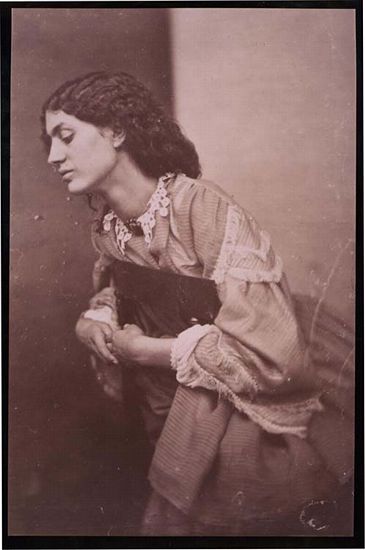
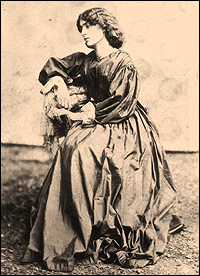

1865.
ѕо этому снимку можно предположить, как –оссетти использовал фотографию.
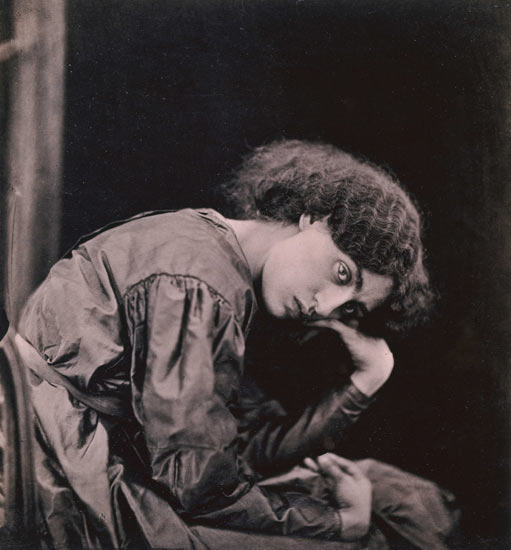
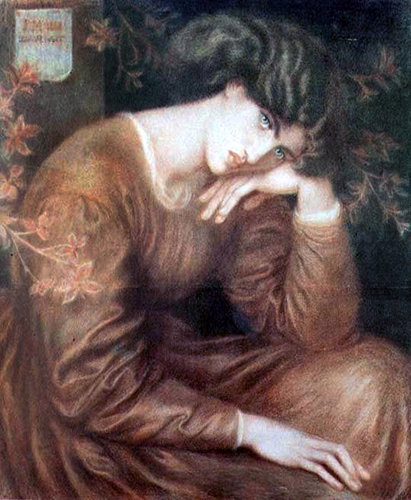
ћ≈„“ј
Reverie, by Dante Gabriel Rossetti
"Ќе могу сказать, что присутствие –оссети вносило большое оживление в общество (в его последние годы). ћоЄ самое характерное впечатление о нЄм той поры: он сидит р€дом с миссис ћоррис, котора€ будто сошла с одного из его полотен, оба неподвижны и погружены в молчание, как будто они в своЄм мире, где слова не нужны. » молчание, как бы ни было оно поэтично, это грех дл€ поэта, чей голос был так музыкален. „то касаетс€ миссис ћоррис, то еЄ голоса € так ни разу и не услышал."
–.≈. ‘рансилльон "¬рспоминани€ о середине викторианской эпохи"
‘I cannot say that Rossetti’s presence was enlivening [in his later years]. My most representative recollection of him is of his sitting beside Mrs. Morris, who looked as if she had stepped out of any one of his pictures, both wrapped in a motionless silence as of a world where they would have no need of words. And silence, however poetically golden, was a sin in a poet whose voice in speech was so musical as his – hers I am sure I never heard.’
R.E. Francillon, Mid-Victorian Memories


ƒом ¬иль€ма и ƒжейн ћоррис - " расный ƒом" знаменит своей архитектурой и совместными усили€ми многих художников по его украшению, что имело следствием целое направление - Arts and Crafts »скусство и –емесло. ¬иль€м и ƒжейн, –оссетти, —иддал, и другие писали фрески, создавали мебель, гобелены и друние художественные шедевры.
The home of William and Jane Morris, The Red House, is famous for its architecture and for the collaborative efforts used to decorate it –decorations which led to the Arts and Crafts movement. Both William and Jane, as well as Rossetti, Burne-Jones, Elizabeth Siddal and others worked together painting murals, creating furniture, tapestries, and other artistic masterpieces.
ѕозже, ƒжейн будет утверждать, что никогда не любила своего мужа. ƒолжно ли нас это шокировать в викторианском браке? ¬озможно, еЄ брак и не был следствием любви, но дл€ необразованной девушки из бедной семьи это был единственный выбор. ≈Є св€зь с –оссетти после смерти жены широко известна. ќна снова начала позировать дл€ –оссетти в 1865 и положила начало серии шедевров знакомых нам всем, –оссетти писал еЄ до самой своей смерти. ≈сли бы не эти полотна, ƒжейн ЅЄрден ћоррис могла бы быть нам совершенно не интересна. ќна осталась бы тихой женой ¬иль€ма ћорриса. Ќо –оссетти схватил что-то в этих ккартинах. Ѕыла ли это она? »ли его мечты, которые вдохновили еЄ черты? ћы никогда не узнаем.
≈сли посмотреть на фото ƒжейн, то сразу понимаешь, что –оссетти значительно прибавил ей гламура. Ќа всех его картинах она серьЄзна и загадочна. ќна кажетс€ тихой и созерцательной. ∆енщина - тайна. ¬озможно она была тайной и дл€ самого –оссетти. „то она чувствовала по этому поводу? ак художник, могу совершенно точно утверждать, что ƒжейн была довольна. ” ѕќ–“–≈“»—“ј ¬џЅќ–ј Ќ≈“, либо похоже, либо красавица. ¬се женщины выбирают ...пон€тно что.

ќднако, не только –оссетти видел в ƒжейн ангельскую красоту, выше приведена картина ЅЄрн-ƒжонса "ќбман ћерлина", обманывает ƒжейн.
The Biguiling of Merlin. (1874, Lady Lever Gallery)
In later years, Jane would claim to have never loved her husband. In a Victorian marriage, should we really find this shocking? Her marriage may not have been born of love, but for a girl with no education and poor family, she made the only marital choice she could have.Her affair with Dante Gabriel Rossetti after his wife died was famous. She began to pose for Rossetti again in 1865, which began a series of Rossetti masterpieces familiar to us all –he painted her repeatedly until his death. And but for his paintings, Jane Burden Morris might not even be of interest to us at all. She would merely be the quiet wife of William Morris.But Rossetti captured something in those paintings. Was it her? Or some element in his own mind that her face inspired? We shall never know.
In viewing actual photographs of Jane, it is obvious that Rossetti glamorized her a great deal. I have to wonder how she felt about this. How did she feel when she saw a painted version of herself that held no resemblance to what she saw in the mirror? How did she feel about herself? Was she proud? Did she prefer the painted version? You may see it differently, but all of Rossetti’s paintings of Jane seem somber, enigmatic. She seems quiet and contemplative. A mystery. Perhaps she was a mystery even to Rossetti.
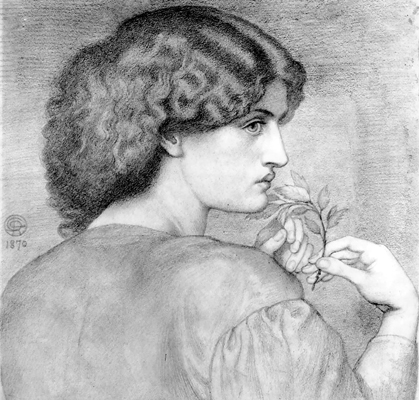
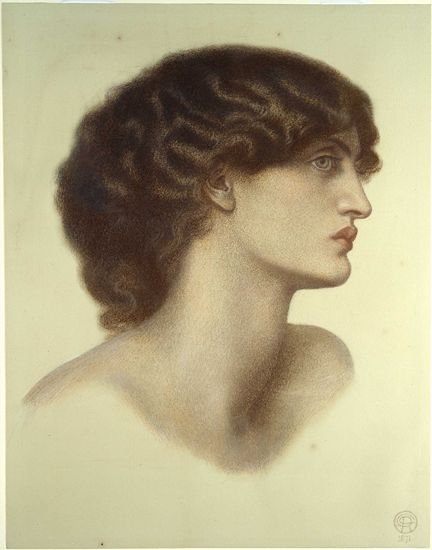
Ћепесток розы A portrait of Jane Morris that .
The Roseleaf, drawn by DGR Rossetti titled Perlascura.
—начала ƒжейн много позировала √абриэлю (в это врем€ его основна€ модель и муза Ћиззи —иддал была в отъезде), однако вскоре √абриэль был отозван на воссоединение с Ћиззи, до которой, возможно, дошли слухи о новой модели. ƒжейн стала позировать ¬иль€му ћоррису. ћоррис был большим поклонником –оссетти, он считал его учителем и их дружба напоминала поклонение герою.
Jane posed mainly for Gabriel at first (his main model and muse, Lizzie Siddal, was away at the time). Gabriel was soon called away to join Lizzie, who had probably heard through the grapevine about Rossetti’s new model. Jane then began to sit for William Morris. Morris was a great admirer of Rossetti’s – he looked upon him as a mentor and it seems as if their friendship bordered upon hero worship.
| Museum: | Victoria and Albert Museum (London) |

ƒ. √. –оссетти. ѕортрет ƒжейн ћоррис с волосами Ћиззи —иддал
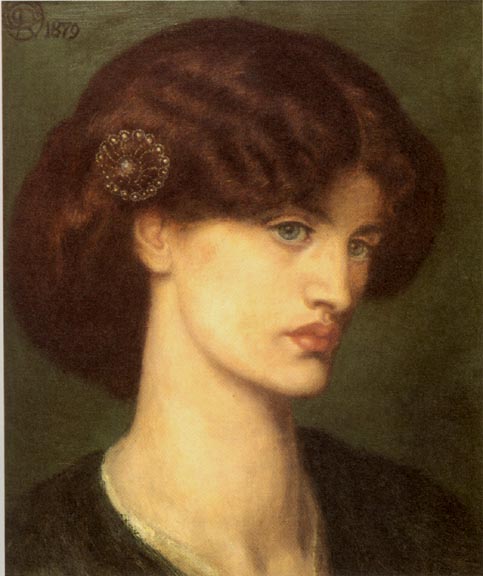
Beatrice, a Portrait of Jane Morris
Signed with monogram and dated 1879 at the upper left
Oil on canvas
13 1/2 x 11 inches.
Inscribed in Rossetti's handwriting on a label on the back of the frame: "Tanto gentile e tanto onesta pare." Dante Vita Nuova
This is a portrait of Jane Morris in the guise of Dante's Beatrice. It is a variation of the half-length seated portrait of her in the role of Mariana which he painted in 1870, and which is now in Aberdeen Art Gallery. — Christopher Newall

Pencil on paper, dated Aug. 12 1870, 24.1 x 45.1cm, The Society of Antiquaries of London (Kelmscott Manor)
ƒжейн ћоррис всю жизнь страдала от болей в спине и часто была настолько больна, что не могла сидеть или сто€ть.

1865.
–оссетти нарисовал не менее п€тнадцати рисунков с ƒжейн, лежащей на софе, большинство с 1870 года. Ѕольшинство исполнено в карандаше или пером, в отличие от более формальных по позе рисунков того же периода, нарисованных цветным мелом.
Jane Morris suffered throughout her life from debilitating back pain and was often too ill to sit up or stand.
Rossetti made at least fifteen drawings of Jane reclining on a sofa, the large majority of which date from 1870. Most are in pencil or pen-and-ink, rather than the more elaborate coloured chalks he used for more formally posed drawings of the same period.
ћел на коричневой бумаге, наложенной на холст.
Evelyn De Morgan
Portrait of Jane Morris
1904
chalks on brown paper laid on canvas
De Morgan Foundation
ƒжейн ЅЄрден умерла 26 €нвар€ 1914 года в Ѕате, где она жила в доме по адресу: Ѕрок-стрит, 5.
ј–“»Ќџ –ќ——≈““» — ћќƒ≈Ћ№ё ƒ∆≈…Ќ.

Astarte Syriaca (1877)
Mystery: lo! betwixt the sun and moon
Astarte of the Syrians: Venus Queen
Ere Aphrodite was. In silver sheen
Her twofold girdle clasps the infinite boon
Of bliss whereof the heaven and earth commune:
And from her neck's inclining flower-stem lean
Love-freighted lips and absolute eyes that wean
The pulse of hearts to the sphere's dominant tune.
Torch-bearing, her sweet ministers compel
All thrones of light beyond the sky and sea
The witnesses of Beauty's face to be:
That face, of Love's all-penetrative spell
Amulet, talisman, and oracle, -
Betwixt the sun and moon a mystery.
----Dante Gabriel Rossetti

ƒама в окне. The Lady of the Window.
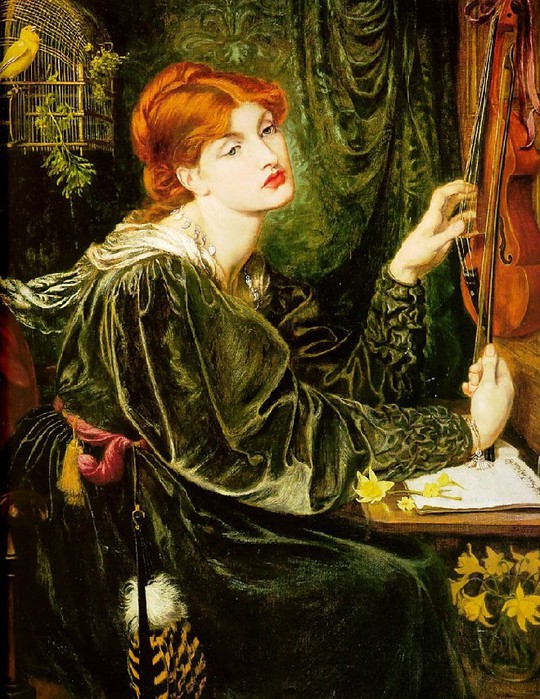
¬ероника ¬еронезе 1872.

ѕјЌƒќ–ј.
—ссылки на сайты о пре-рафаэлитах:
http://www.all-art.org/history392-5.html
ћетки: моррис Jane джейн burden morris бЄрден |
| —траницы: | [1] |










